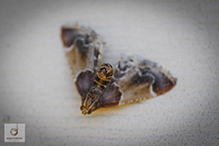Meal moth
(Pyralis farinalis)
Conservation • Description • Habitat • Ecology • Distribution • Taxonomy
|
|
||||||||||||||||||
Description |
Meal moth is a small, broad-winged, triangular, pyralid moth. It is cosmopolitan, occurring around the world, but is most common in Europe and the United States. It is found anywhere grain is processed or stored, including warehouses, barns, and most home pantries. It is not the only moth common to home pantries, nor is it the most common. That distinction belongs to Indian meal moth. Other common pantry moths are Mediterranean flour moth, brown house moth, and white shouldered house moth. Meal moth larva feed on cereals (plants in the Poaceae [grass] family), grains (edible seeds of cereals), and vegetables, including potatoes. Adults do not feed and are short-lived. They mate as soon as possible after emerging, then die after nine or ten days. Adults are 9⁄16″ to ⅝″ (14 to 16 mm) in length and have a 11⁄16″ to 1 3⁄16″ (18 to 30 mm) wingspan. The protruding mouthparts (proboscis) are scaled at the base. The sensory appendages (palps) attached to the upper lip (labrum) are long and turned upward in front of the head. The forewing is elongate triangular. The basal area is chestnut brown, the median area is fawn-colored, and the subterminal area is chestnut brown. The antemedial (AM) and postmedial (PM) lines are white. The hindwing is broad and rounded. The subcostal plus first branch of the radial vein (Sc+R1) is fused beyond the discal cell to the radial sector (Rs), then separated for more than half of its length. |
Size |
Total length: 9⁄16″ to ⅝″ (14 to 16 mm) Wingspan: 11⁄16″ to 1 3⁄16″ (18 to 30 mm) |
Similar Species |
Habitat |
Cereals, grains, and vegetables |
Ecology |
Season |
Four generations per year: May to August outdoors, year round indoors |
Behavior |
Adults rest with their wings spread wide, their abdomen raised at a right angle to the body, and their antennae folded back over the body. |
Life Cycle |
|
Larva Hosts |
Mostly cereals but also other grains and vegetables, including potatoes. |
Adult Food |
Adults do not feed |
Distribution |
||
|
Sources 21, 22, 24, 29, 30, 75, 82, 83. Biodiversity occurrence data published by: Minnesota Biodiversity Atlas (accessed through the Minnesota Biodiversity Atlas Portal, bellatlas.umn.edu, 8/17/2025). |
|
| 8/17/2025 | ||
Occurrence |
||
Common and widespread |
||
Taxonomy |
|
Order |
|
Superfamily |
Pyraloidea (Pyralid and Crambid Snout Moths) |
Family |
Pyralidae (Pyralid Snout Moths) |
Subfamily |
Pyralinae |
Tribe |
Pyralini |
Genus |
Pyralis (Meal Moths) |
Subordinate Taxa |
|
|
|
Synonyms |
|
Asopia domesticalis Asopia farinalis Phalaena erecta Phalaena farinalis Pyralis domesticalis Pyralis erecta Pyralis farinatis Pyralis fraterna Pyralis manihotalis Pyralis marianii Pyralis meridionalis Pyralis orientalis Pyralis sardoplumbea Pyralis tenerifensis |
|
Common Names |
|
meal moth |
|
Glossary
Palp
Short for pedipalp. A segmented, finger-like process of an arthropod; one is attached to each maxilla and two are attached to the labium. They function as sense organs in spiders and insects, and as weapons in scorpions. Plural: palpi or palps.
Proboscis
The tube-like protruding mouthpart(s) of a sucking insect.
Visitor Photos |
||
Share your photo of this insect. |
||
This button not working for you? |
||
Luciearl |
||
 |
 |
|
Mike Poeppe |
 |
MinnesotaSeasons.com Photos |
||
|
||
|
||

Slideshows |
|

Visitor Videos |
||
Share your video of this insect. |
||
This button not working for you? |
||
|
Other Videos |
||
Meal Moth (Pyralidae: Pyralis farinalis) on Wall |
About
Aug 29, 2010 Photographed near Fisher, Minnesota (29 August 2010). Go here to view other images of this species: http://www.eol.org/pages/171824 |
Meal moth, Pyralis farinalis (?) |
About
Jul 8, 2016 This video shows what I think is a meal moth (Pyralis farinalis) that I found in my house. Sealing flour and other food sources in containers can help prevent these moths. |

Created: 7/26/2022 Last Updated: © MinnesotaSeasons.com. All rights reserved. |



